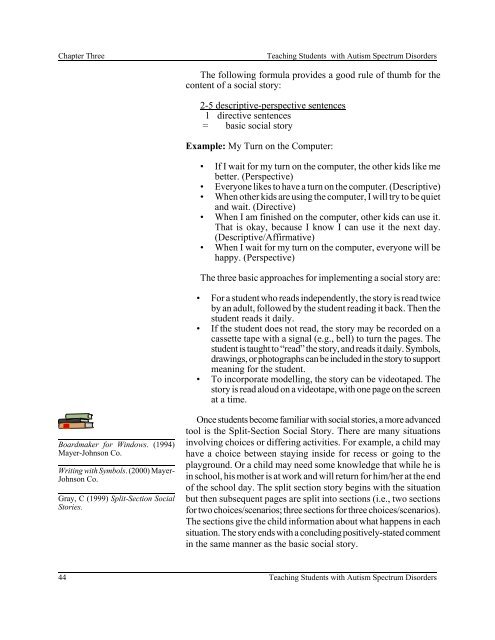Teaching Students with Autism Spectrum Disorders
Teaching Students with Autism Spectrum Disorders
Teaching Students with Autism Spectrum Disorders
You also want an ePaper? Increase the reach of your titles
YUMPU automatically turns print PDFs into web optimized ePapers that Google loves.
Chapter Three <strong>Teaching</strong> <strong>Students</strong> <strong>with</strong> <strong>Autism</strong> <strong>Spectrum</strong> <strong>Disorders</strong><br />
Boardmaker for Windows. (1994)<br />
Mayer-Johnson Co.<br />
Writing <strong>with</strong> Symbols. (2000) Mayer-<br />
Johnson Co.<br />
Gray, C (1999) Split-Section Social<br />
Stories.<br />
The following formula provides a good rule of thumb for the<br />
content of a social story:<br />
2-5 descriptive-perspective sentences<br />
1 directive sentences<br />
= basic social story<br />
Example: My Turn on the Computer:<br />
• If I wait for my turn on the computer, the other kids like me<br />
better. (Perspective)<br />
• Everyone likes to have a turn on the computer. (Descriptive)<br />
• When other kids are using the computer, I will try to be quiet<br />
and wait. (Directive)<br />
• When I am finished on the computer, other kids can use it.<br />
That is okay, because I know I can use it the next day.<br />
(Descriptive/Affirmative)<br />
• When I wait for my turn on the computer, everyone will be<br />
happy. (Perspective)<br />
The three basic approaches for implementing a social story are:<br />
• For a student who reads independently, the story is read twice<br />
by an adult, followed by the student reading it back. Then the<br />
student reads it daily.<br />
• If the student does not read, the story may be recorded on a<br />
cassette tape <strong>with</strong> a signal (e.g., bell) to turn the pages. The<br />
student is taught to “read” the story, and reads it daily. Symbols,<br />
drawings, or photographs can be included in the story to support<br />
meaning for the student.<br />
• To incorporate modelling, the story can be videotaped. The<br />
story is read aloud on a videotape, <strong>with</strong> one page on the screen<br />
at a time.<br />
Once students become familiar <strong>with</strong> social stories, a more advanced<br />
tool is the Split-Section Social Story. There are many situations<br />
involving choices or differing activities. For example, a child may<br />
have a choice between staying inside for recess or going to the<br />
playground. Or a child may need some knowledge that while he is<br />
in school, his mother is at work and will return for him/her at the end<br />
of the school day. The split section story begins <strong>with</strong> the situation<br />
but then subsequent pages are split into sections (i.e., two sections<br />
for two choices/scenarios; three sections for three choices/scenarios).<br />
The sections give the child information about what happens in each<br />
situation. The story ends <strong>with</strong> a concluding positively-stated comment<br />
in the same manner as the basic social story.<br />
44 <strong>Teaching</strong> <strong>Students</strong> <strong>with</strong> <strong>Autism</strong> <strong>Spectrum</strong> <strong>Disorders</strong>

















